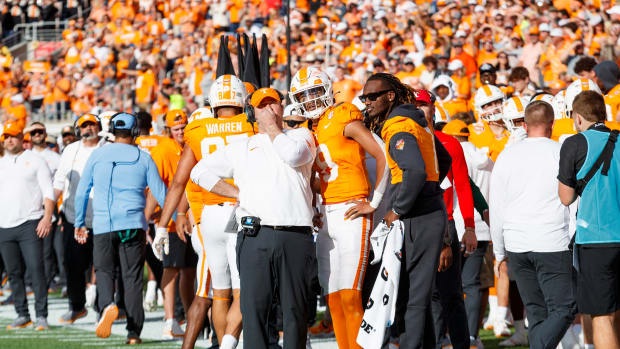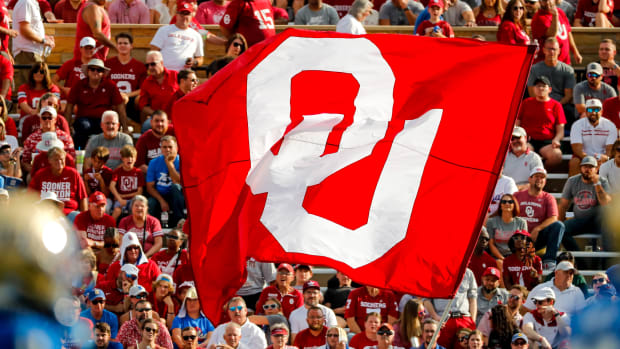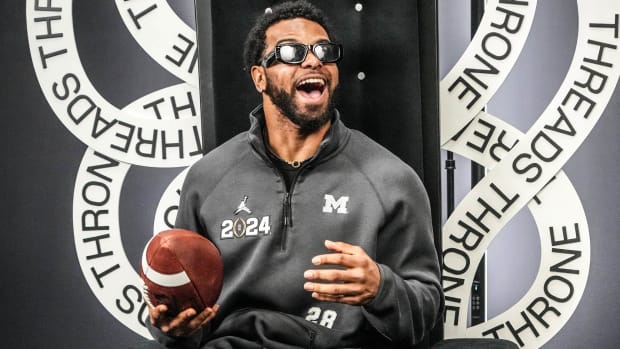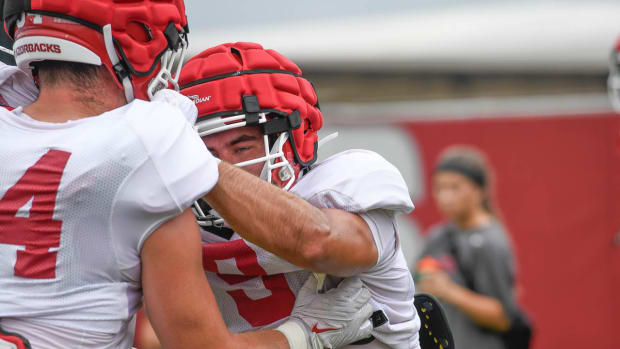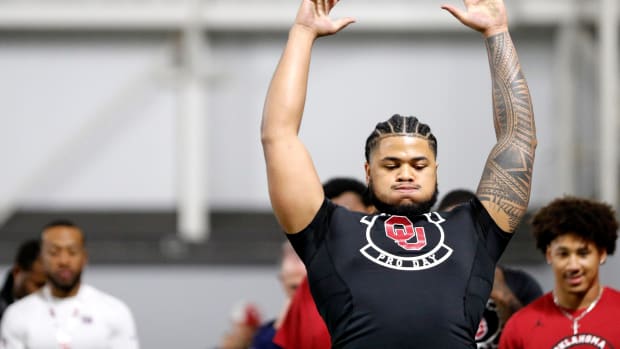
Flipping the script: Missouri strike proves that players, not the NCAA, hold the power in collegiate athletics
Did the athletes who play big-money sports at big-money universities feel the tremor on Monday? Did they understand the deeper meaning of what happened in Columbia, Mo.? Because while the end result of that situation affected only one state university system, the aftershocks could affect all of major college sports.
This has nothing to do with why some Missouri football players joined other student groups in protest and promised to boycott football activities until University of Missouri system president Tim Wolfe resigned or got fired. (He resigned Monday.) If you'd like to debate the specifics of the Missouri case, go to the cable news channel that corresponds to your particular political affiliation and have at it. This isn't about any one particular issue. It's about power. Specifically, it's about a group of people who felt powerless until just recently. After Monday, that group should have a deeper understanding of exactly how much power it holds.
If Power Five conference football and men's basketball players want to change the rules regarding scholarships or transfers or player compensation, they don't need to file any more federal lawsuits. That process is slow, convoluted and could ultimately be circumvented by good lobbying on the part of the people in charge. If the players want to create meaningful change, their colleagues at Missouri have already given them the blueprint. And because the schools and NCAA have hamstrung themselves with their own rhetoric and legal defenses, there isn't anything they could do in response but negotiate.
Because of the way the economics of major college football and men's basketball have changed over the past 30 years, players have substantially more power than they know. If they choose to, they can demand change and win. The most fascinating part is the schools simply handed that power to them without even realizing it.
Ramogi Huma is a former UCLA football player who runs the National Collegiate Players Association. His group helped spearhead the football unionization attempt at Northwestern. It has aided players who are suing the NCAA and conferences over issues such as cost of attendance and name, image and likeness rights. Huma probably watched the events in Columbia with more interest than anyone else who had no connection to the University of Missouri. He saw football players take a stand and turn a local issue into a national one. Once the football players joined the protest, everyone paid attention. "This highlights for players across the nation how much power they have to affect change," Huma said Monday. "It's interesting because at some point you wonder if this is the point where players truly start to connect the dots in a real way."
That has been the issue in the fight for the players to get a bigger piece of an economic pie that has expanded rapidly since the Supreme Court ruled in favor of the schools against the NCAA in 1984 and allowed schools to sell the television rights to their own football games. Players have always felt they were powerless against their own school administrations and against the ruling body of college sports. What happened in Missouri suggests that wouldn't be the case. "They are the face of the university. Universities get more media because of their sports programs than anything else," said Huma, who wanted it made clear that he is not calling for any boycotts now. "They have the power to affect the brand of the university, future student applications, future recruiting and, of course, millions of dollars on their campus." In other words, the athletes have far more leverage than they realize.
Had Missouri players boycotted Saturday's game against BYU in Kansas City, Missouri would have been on the hook for a $1 million penalty according to the game contract. That does not include the ire Missouri would have drawn from ESPN, which pays Missouri (through the SEC) for the rights to a game it plans to broadcast on its SEC Network.
Ed Zurga/Getty Images
Now imagine if players in an entire conference decided they wanted lifetime medical coverage for injuries incurred while playing college football. Or imagine they decided that they merely wanted a bigger cut of the millions that currently go to their coaches, their athletic directors, their locker room waterfalls and to subsidize sports on their campus that don't make any money. Here are a few potential courses of action and their likely results.
- They could write a strongly worded letter. That would be ignored.
- They could sue. That would take years.
- They could threaten to skip their games. They would have everyone's attention immediately.
If they did it, the schools, conference and NCAA could do absolutely nothing but begin negotiating. Why? Because those groups gave the athletes the power the moment they got into the business of producing and selling television shows. Then, in an attempt to defend their economic model in court and before the National Labor Relations Board, they took away any opportunity they would have had to threaten retaliation.
The Pac-12 and Big Ten own pieces of their eponymous television networks. The SEC takes a huge licensing fee from ESPN to take part in the SEC Network. All the leagues sell games—television shows, essentially—to networks independent of any conference cable network deal. Media companies pay through the nose for the right to broadcast those television shows. How mad would they be at the people who sold them those shows if the casts suddenly didn't show up for scheduled episodes?
What could the schools do in such a situation? Nothing. They can't revoke the players' scholarships, because the NCAA's attorneys have spent years spitting out court filings that claim the key reason athletes should not be paid to play college sports is that they are simply members of the student body participating in an extracurricular activity. Northwestern's attorneys argued to the NLRB that athletes are not employees because they are, in fact, regular students. "Northwestern considers its students who participate in NCAA Division I sports, including those who receive athletic scholarships, to be students, first and foremost," Northwestern vice president for university relations Alan Cubbage wrote in a statement on March 26, 2014. "We believe that participation in athletic events is part of the overall educational experience for those students, not a separate activity."
Of course athletes are different from regular students. Of course the athletic scholarship is a form of compensation that has far less to do with school than it does with sports. But when you've spent years pretending under oath that athletes are average students and their scholarships aren't tied to their performance on the field, then you can't yank their scholarships for organizing a boycott. That's something regular students do a lot. They belong to a very idealistic age group. Protests are part of the deal on a college campus.
To discipline players who boycott would be an admission that their scholarship is compensation for their athletic participation. (Again, of course it's compensation for athletic participation. The people in charge have chosen to pretend it isn't.) It would also be an admission that revenue sport athletes aren't regular students. Regular students wouldn't lose their financial aid for protesting peacefully.
College sports leaders have argued for years that it isn't the name on the back of the jersey but the one on the front that truly matters to college sports fans. It would be quite an experiment to put that theory to the test. If all the football players in the Power Five decide on a Tuesday next October that they won't play until their demands are addressed, would schools simply pluck more players from the student body, hand them pads and trot them out that Saturday to fulfill their conference television contract obligations? Of course they wouldn't. None except the morbidly curious would watch those games. It wouldn't take more than a few weeks before conference commissioners and athletic directors began begging players to unionize so a collective bargaining agreement could be hammered out. No one wants to derail the cash train, and the wise among the leaders would realize that sometimes you must spend some money to keep making more money.
The schools have boxed themselves in on this issue, and now the players have a better understanding of the leverage they have. Some leaders, including Stanford athletic director Bernard Muir and Notre Dame athletic director Jack Swarbrick, have suggested their schools would get out of major college athletics altogether rather than give the players more than the full cost of attendance they provide now. (Note: They only agreed to provide full cost of attendance after getting sued in federal court.)
The idea of a drop from Division I to Division III is laughable. They won't do that because human nature doesn't work that way. A single person might walk away from a pile of money to make a principled stand. People, in general, will not. As long as there are huge sums to be made running college football programs, there will be people willing to run them.
But those people who run college football programs—and big-time men's basketball programs as well—are going to have to change how they deal with their athletes. Through a series of choices, the people who rule college sports have ceded a huge chunk of their power to the athletes they govern. After Monday, those athletes might finally understand just how much power they've been granted.
The only question now is this: When will they begin to use it?

